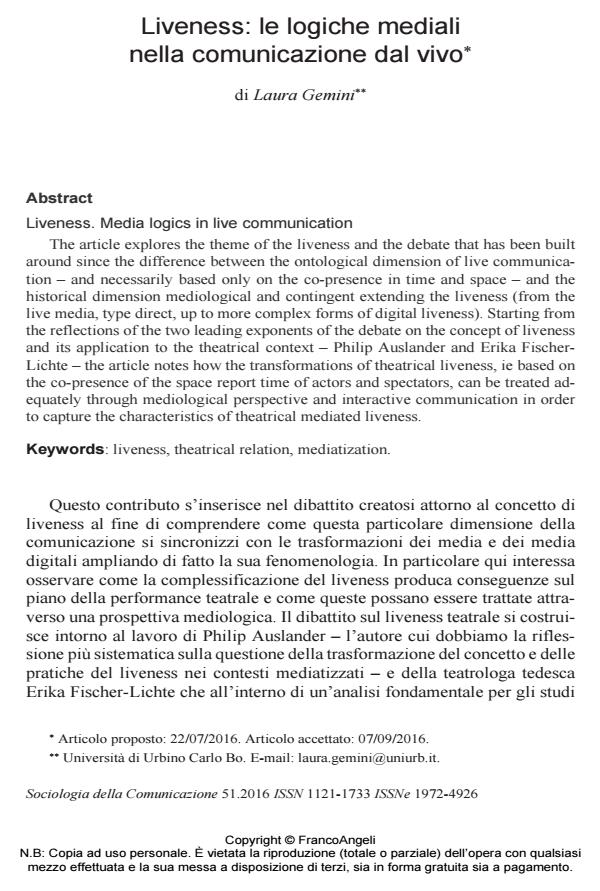Liveness. Media logics in live communication
Journal title SOCIOLOGIA DELLA COMUNICAZIONE
Author/s Laura Gemini
Publishing Year 2016 Issue 2016/51
Language Italian Pages 21 P. 43-63 File size 284 KB
DOI 10.3280/SC2016-051004
DOI is like a bar code for intellectual property: to have more infomation
click here
Below, you can see the article first page
If you want to buy this article in PDF format, you can do it, following the instructions to buy download credits

FrancoAngeli is member of Publishers International Linking Association, Inc (PILA), a not-for-profit association which run the CrossRef service enabling links to and from online scholarly content.
The article explores the theme of the liveness and the debate that has been built around since the difference between the ontological dimension of live communication - and necessarily based only on the co-presence in time and space - and the historical dimension mediological and contingent extending the liveness (from the live media, type direct, up to more complex forms of digital liveness). Starting from the reflections of the two leading exponents of the debate on the concept of liveness and its application to the theatrical context - Philip Auslander and Erika Fischer-Lichte - the article notes how the transformations of theatrical liveness, ie based on the co-presence of the space report time of actors and spectators, can be treated adequately through mediological perspective and interactive communication in order to capture the characteristics of theatrical mediated liveness.
Keywords: Liveness, theatrical relation, mediatization.
- Il lavoro dello spettatore dal vivo: capitale culturale ed esperienza. Il caso del pubblico del Rossini Opera Festival Laura Gemini, Roberta Bartoletti, Stefano Brilli, in SOCIOLOGIA DELLA COMUNICAZIONE 56/2018 pp.43
DOI: 10.3280/SC2018-056004 - Theatre without theatres: Investigating access barriers to mediatized theatre and digital liveness during the covid-19 pandemic Stefano Brilli, Laura Gemini, Francesca Giuliani, in Poetics 101750/2023 pp.101750
DOI: 10.1016/j.poetic.2022.101750 - On theatre mediatisation: exploring transmediality inAldo Morto 54 Laura Gemini, Stefano Brilli, in International Journal of Performance Arts and Digital Media /2020 pp.150
DOI: 10.1080/14794713.2020.1773698 - Antidoto liveness. La performance dal vivo durante il Covid-19 Laura Gemini, in SOCIOLOGIA DELLA COMUNICAZIONE 60/2021 pp.104
DOI: 10.3280/SC2020-060010 - L'audience development nelle poetiche. Clessidra del Teatro delle Forche a Chiatona Lorenzo Donati, in SOCIOLOGIA DELLA COMUNICAZIONE 56/2018 pp.103
DOI: 10.3280/SC2018-056007
Laura Gemini, Liveness: le logiche mediali nella comunicazione dal vivo in "SOCIOLOGIA DELLA COMUNICAZIONE " 51/2016, pp 43-63, DOI: 10.3280/SC2016-051004